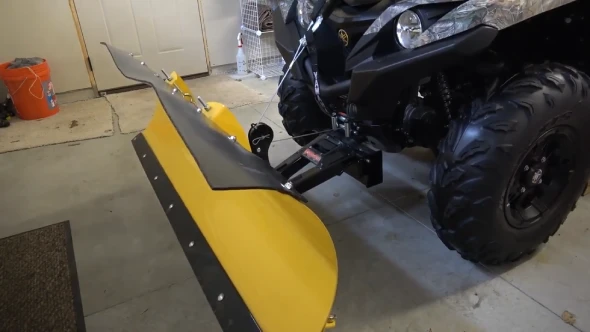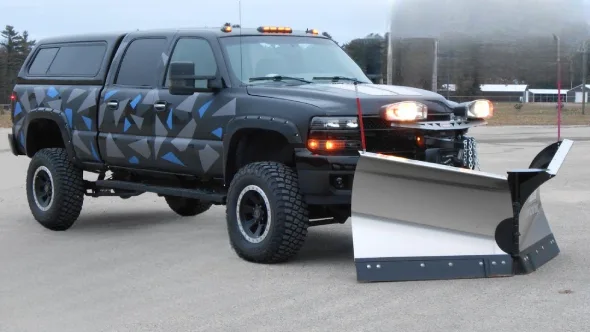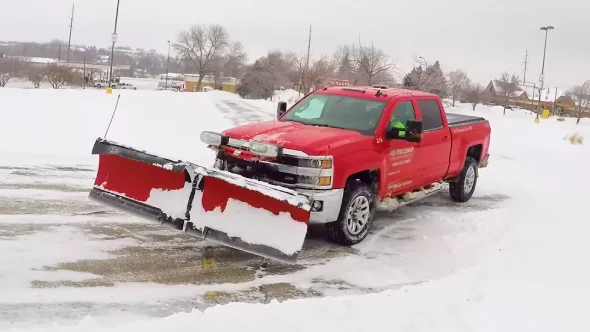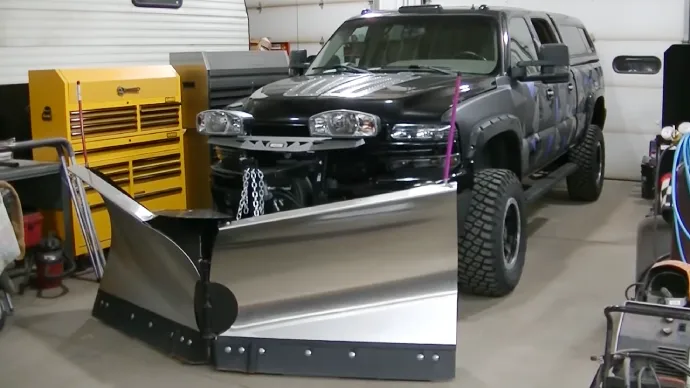Last Updated on March 19, 2023
Are you looking to use your lifted truck for more than just off-roading? Believe it or not, with a few modifications, you can use your lifted truck to plow snow. Plowing with a lift kit may seem daunting, but it is possible with the right modifications and precautions.
From reinforcing the truck frame, watching out for plow clearance, leveling the push plates or A-arms, and using snow-compatible tires, make sure you take all the steps necessary to ensure that you can plow efficiently and safely. And when it comes to big trucks, the plow weight matters too.
Throughout this article, we will discuss the necessary vehicle modifications to plow snow with a lifted truck. We will also explore the factors to consider when plowing with your lifted truck. So continue reading to find out more.
Can You Plow With a Lift Kit: Vehicle Modifications

Snow plowing with a lifted vehicle is becoming increasingly popular due to its ability to traverse uneven terrain and maximize the effectiveness of plowing. Several modifications must be made to a vehicle for it to be ready for snow plowing, including:
Reinforce the Truck Frame
Any vehicle used for snow plowing must have its frame reinforced to provide extra stability and reduce flexing during heavy snow removal activities. The first step is adding bracing along the truck frame, such as cross members or an X-brace on either side of the frame rails.
This will help spread stress demands across multiple points, which helps reduce flexing from occurring over time due to repeated impacts from pushing large amounts of snow.
Also, weld-on gussets can be added at key stress points along the entire frame, further reinforcing and preventing excessive flexing or warping over time.
Watch Out for Clearance
When putting a lift kit on a vehicle that will be used for snow plowing, you must pay close attention to clearance issues. The increased size of tires associated with most lift kits can cause interference issues with stationary objects such as road curbs and drainage ditches, as well as other vehicles while out on the roadways.
Therefore, it is essential that when selecting a lift kit for a vehicle intended for snow plowing, appropriate ground clearance levels are maintained so problems can be avoided altogether.
Furthermore, adequate clearance needs to be maintained between all components under the body of the vehicle, such as suspension arms, steering components, brake lines, exhaust system parts, and more, to prevent any damage caused by impacts from snow pushed during operations.
Level the Push Plates or the A-Arms
Most lift kits installed on vehicles intended for snow removal operations to function properly must be leveled correctly before use to ensure proper force distribution during use.
If these components are not leveled correctly, this can lead to premature wear or failure of various systems due to uneven force application throughout operations. This would result in costly repairs down the line if left unchecked currently.
To properly level these components, lift blocks should be installed at both ends until they reach an even height off the ground surface before operations begin. This ensures proper force distribution throughout operations resulting in better overall performance using a lifted vehicle for snow plowing.
Plow Weight Matters
When attempting to plow snow with a lift-kit-equipped vehicle, it’s essential to consider the plow’s weight. The right weight is necessary to move large amounts of snow at once.
If your plow is too light, it won’t be able to move lots of snow, while if it’s too heavy, it could cause extra strain on your vehicle and potentially damage parts or wear them out prematurely. Consider the size of your lift-kit rig and adjust accordingly based on the plowing you plan.
Use Snow-Compatible Tires
Using tires that are designed for driving & plowing in snowy conditions is essential for successful winter operations with a modified vehicle. All-terrain tires will work well for light-duty applications such as parking lot clearing.
But more intense jobs may require deeper treads or even specialty chains, depending on how much traction your area needs during winter.
Remember that all-terrain bigger tires can still become slick in wet or icy conditions, so never assume they are enough alone for deep winter weather conditions without investigating further before purchasing any gear for your modified ride.
Big Trucks Can Push Big Snow
For larger areas requiring more coverage, it might be necessary to use a bigger truck or SUV equipped with a suspension lift kit to effectively clear away all the snowfall from a large area like an entire parking lot.
Larger trucks have more power and can easily push through heavy piles of packed down or frozen-over snow without having any trouble due to their increased engine power and stronger axles/transmissions, which can handle heavier loads over time than smaller cars & SUVs.
What Factors Should be Considered When Plowing With a Lifted Truck?

Plowing with a lifted truck is an efficient and cost-effective way to increase the capabilities of a plow, but there are important factors to consider when making this choice. These includes:
Plow Size and Weight
When choosing a plow for a lifted truck, selecting one that is properly sized for the job at hand is essential. The size of the plow will determine how much snow it can clear with each pass and how maneuverable it is around obstacles like curbs or small spaces.
It is also essential to consider the weight of the plow. If it is too heavy, it may cause undue strain on both the vehicle and its suspension system. A qualified professional can help choose a size and weight appropriate for any specific application.
Plow Clearance to Vehicle
It is also necessary for individuals using a lifted truck for professional snow removal to consider how much clearance their truck has from the ground up to where their plow attaches to their vehicle.
For proper operation, this distance should be at least 18 inches so as not to cause excessive strain on the lift kit or other components, such as cables or lift arms. If the additional lift is needed, specialized kits designed for this purpose can be purchased from most automotive supply stores or online retailers.
Plow Ground Clearance
When operating a lifted truck for snow removal, Users should know how much ground clearance their chosen setup has. If too little ground clearance exists, they may be unable to traverse certain terrain due to objects like rocks or large pieces of debris being in their path.
Ideally, sufficient ground clearance (half-inch above the surface) should be provided by adding extensions or other devices that raise or suspend parts of the plow system away from the surface below them.
Snow Plowing Terrain
Terrain is one of the most important factors when considering lifted truck snow plowing. Depending on the terrain you are working with, a lifted vehicle may be more or less effective than an average-height truck.
A lifted truck can provide greater maneuverability on flat or semi-flat surfaces thanks to its improved ground clearance and larger tires. But on uneven or hilly terrain, the additional height makes it more difficult to control the vehicle due to increased leverage and reduced ground contact area due to smaller tire sizes.
Also, if there is deep snow on hilly or uneven terrain, the additional lift can make it much harder for the vehicle’s tires to gain traction due to their reduced size.
Headlight Aim
Another factor that should be considered when utilizing a raised truck for snow plowing is headlight aim. In low light conditions like heavy snowfall or at night, you’ll have less visibility because their mounting position determines the angle at which headlights shine.
To help improve visibility and safety while operating a lifted truck for snow plowing purposes, you should adjust your headlights accordingly so that they are aimed toward where you intend to drive rather than straight ahead of you at all times.
Suspension Geometry
Suspension geometry matters when using a lifted truck for snow plowing. Getting your vehicle raised higher off the ground surface will change your vehicle’s suspension geometry and ride quality compared to its original positioning before it was raised higher off the ground.
This is important to know when you lift your vehicle to get more ground clearance and avoid getting stuck in deep snow drifts or other difficult terrain features. Commercial-grade snow plows require a technician to inspect the raised suspension system on your vehicle before use in winter weather.
To ensure optimal performance when you drive over snowy roads and other hazardous winter conditions like ice patches, etc., it is recommended to have an experienced technician inspect all the components.
What Size Truck is Best for Snow Plowing With a Lift Kit?

When it comes to snow plowing with a lift kit, the heavier the truck, the better. The ideal size truck for this job should weigh at least 1500 pounds or more to provide enough traction and stability while pushing large amounts of snow.
Heavier trucks also have higher ground clearance, which is essential when operating in steep terrain or off-road conditions. Also, heavy-duty vehicles are less likely to become stuck in deep snow or mud due to their increased weight capacity and superior tires.
How High Should My Plow be Set Off the Ground With a Lift Kit Installed?
When installing a lift kit on your vehicle for snow plowing purposes, it is recommended that you set your plow approximately half an inch above the ground level to not scrape against any uneven surfaces beneath it when being operated.
This will help prevent unnecessary damage and ensure the blade will glide smoothly across whatever surface it is coming into contact with. This slight height difference improves maneuverability in tight spaces or around obstacles such as parked cars or street signs.
Do You Need a Leveling Kit for a Plow With a Lift Kit?
Typically, you only need leveling kits for a snow plow blade with a lift kit if product specs or manufacturer guidelines say it’s necessary.
But, if you need to raise the mount attachment point on your car to fit within the range of necessary blades and other snow removal equipment, you may consider using a leveling kit. This will help ensure a secure connection between ground clearance and job-specific considerations regarding snow clearing.
What are the Risks of Plowing With a Lifted Vehicle?

Some of the risks associated with plowing with a raised vehicle include the following:
Vehicle Stability
Plowing with lifted trucks or SUVs can risk the vehicle’s stability and safety in snowy conditions. As the center of gravity is higher, it can be difficult for the vehicle to maintain a grip on slippery surfaces and turn corners at speed.
This increases the chances of losing control and having an accident. Also, due to the raised height, there may be reduced stability when driving across uneven terrain or over bumps.
Vehicle Traction
Plowing with a raised truck or SUV can also reduce traction significantly compared to an unmodified vehicle.
Higher ground clearance means that the tires do not sit as close to the surface, making it far more difficult to grip icy and snowy conditions, which could lead to spinning wheels when pulling heavy loads up hills or sharp turns.
The size of the tires can also affect traction; wider tires will provide more grip but decrease overall stability when cornering at speed.
Braking Performance
When plowing using a lifted truck or SUV, braking performance is also adversely affected. The additional lift raises the braking point farther away from the ground than normal, reducing overall stopping power and making it much harder to judge distances correctly while coming to a halt in snowy conditions.
Also, as lift adds extra weight to a vehicle’s suspension system, it increases braking reaction time and makes it more difficult for brakes to respond quickly enough in emergencies.
Equipment Compatibility
Plowing with a lifted truck or SUV may require additional modifications, such as larger rims or tires and stronger shocks for certain equipment (such as snowplows) to fit properly onto the vehicle. This could increase components’ cost and wear-and-tear due to added strain from pulling heavier weights.
Also, there is potential for compatibility issues between different parts being used which could lead to further complications down the line if not addressed properly beforehand.
Legal Issues
In some areas plowing with lifted cars may not be allowed due to local regulations around road safety standards. This could result in fines if caught without prior authorization from authorities responsible for traffic law enforcement in that area.
Further legal issues may arise from plow operators using vehicles deemed unsafe due to modifications made without considering all necessary safety precautions beforehand. Which could leave operators liable should an accident occur during operations involving these vehicles.
Plow Snow with a Lifted Vehicle: Extra Prep and Safety Steps for Snow Removal Success
Plowing snow with a lifted truck does require some additional preparation and safety precautions compared to traditional plows. But when done properly, lifting kits can certainly be used for snow removal.
Even though some precautions need to be taken to ensure compatibility, these modifications are relatively easy and can make a big difference when clearing snow off driveways and sidewalks.
Do not hesitate if you were worried about your truck’s ability to handle winter weather conditions before adding a lifting kit. Your lifted truck is more than capable of taking on even large piles of snow.
